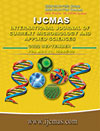


 National Academy of Agricultural Sciences (NAAS)
National Academy of Agricultural Sciences (NAAS)

|
PRINT ISSN : 2319-7692
Online ISSN : 2319-7706 Issues : 12 per year Publisher : Excellent Publishers Email : editorijcmas@gmail.com / submit@ijcmas.com Editor-in-chief: Dr.M.Prakash Index Copernicus ICV 2018: 95.39 NAAS RATING 2020: 5.38 |
A total of fifty multiparous ewes were selected immediately after lambing to study the relationship between udder morphology traits and milk production of Najdi and Naeimi ewes (n=25/ breed) under intensive Saudi Arabia condition. Immediately after lambing, lambs were allowed to suckle freely for 8 weeks; there after lambs were weaned. During suckling period, udder typology, udder depth and suspensory ligament in the udder wear visually evaluated 3 weeks after lambing. One week before weaning (Week 7), udder measurements and daily milk yield potential were determined. After weaning (Week 9), milk yield and composition wear determined, as well as cisternal and alveolar milk was measured 8h after the morning milking. Udders of Type II were the most frequent (45.6%) in both breeds. However, Naeimi breed showed a higher incidence (19.3%) of Type III, whereas Najdi sheep presented a larger percentage (29.8%) of Type I udders. The incidence of Type IV wear high (17.6%) in the two breeds. The presence of the suspensors ligaments wear observed in 75% and 46% of Najdi and Naeimi ewes, respectively. The proportion of Najdi and Naeimi ewes with udder depth over the level of the hook was 51% and 56%, respectively. Litter size and gender of lambs did not affect (p > 0.05) milk yield and udder measurements, but gender of lambs significantly (p < 0.05) affected teats length and width. In addition, lamb’s birth weight significantly affected milk yield (p < 0.05) and teat length and angle (p < 0.01) in Najdi and Naeimi ewes. Birth weight and gender of lambs did not produce any significant effect on milk composition, but litter of size significantly affected milk fat and total solids content. Najdi ewes produced greater (+33.3%; p < 0.01) milk yield and presented greater (P<0.01) udder depth, teat length and distance between teat than Naeimi ewes. Milk composition did not differ between Najdi and Naeimi ewes one week before weaning. The SCC varied significantly (P<0.05) between breeds and had a mean value of 9.7×105 cells/mL (log SCC = 6.16) and 6.6×105 cells/mL (log SCC = 5.5) in Najdi and Naeimi ewes, respectively. On average, cisternal milk accounted for 64% and 53% of the total udder milk in Najdi and Naeimi ewes, respectively. Fat percentages in alveolar milk were 41% and 37% greater (p < 0.05) than cisternal milk one week after weaning in Najdi and Naeimi ewes, respectively. In conclusion the indigenous Najdi and Naeimi ewes had acceptable udder morphology traits for machine milking. Udder morphology measurements and milk fractions had positive correlations with milk yield and can be adopted in breeding programs.
 |
 |
 |
 |
 |